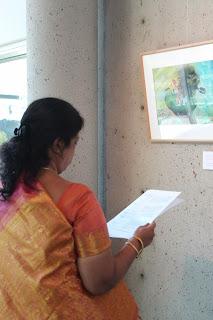The six of the nine Japanese artists who created Fukushima art exhibit are coming to Vancouver this week.
The master mind behind the art retreat, is my new friend, Steve Frost, a poet, painter, author, teacher and friend. Here's his gift of welcome to these artists coming together from Fukushima and from various corners of our city, Vancouver: A poem by Wendell Berry!
How to be a Poet by Wendell Berry (with Japanese translation by Sora)
- Wednesday, June 10 at noon: Meet the Artists, at Regent College.
- Thursday, June 11 - Saturday, June 13, all day: they will work with some Canadian artists in downtown east side and Strathcona neighborhoods of Vancouver on an art retreat, Soul Sustainability: Urban Renewal through Art.
The master mind behind the art retreat, is my new friend, Steve Frost, a poet, painter, author, teacher and friend. Here's his gift of welcome to these artists coming together from Fukushima and from various corners of our city, Vancouver: A poem by Wendell Berry!
How to be a Poet by Wendell Berry (with Japanese translation by Sora)
Even though we aren’t all together yet, through the power of poetry we can start aligning our hearts and minds. We’ll be using this Wendell Berry poem for morning meditation over the weekend. Sora and Steve translated it into Japanese. Please read and reflect as you prepare to gather with fellow artists. Our difference is our strength.
HOW TO BE A POET
(to remind myself)
Make a place to sit down.
Sit down. Be quiet.
You must depend upon
affection, reading, knowledge,
skill ― more of each
than you have ― inspiration,
work, growing older, patience,
for patience joins time
to eternity. Any readers
who like your poems,
doubt their judgment.
Breathe with unconditional breath
the unconditioned air.
Shun electric wire.
Communicate slowly. Live
a three-dimensioned life;
stay away from screens.
Stay away from anything
that obscures the place it is in.
There are no unsacred places;
there are only sacred places
and desecrated places.
Accept what comes from silence.
Make the best you can of it.
Of the little words that come
out of the silence, like prayers
prayed back to the one who prays,
make a poem that does not disturb
the silence from which it came.
詩人のあり方(自分自身のために)
座る場所を作る
座る
静かに
永遠とつながる強さのために
愛情、読書、知識、技術
閃き、労働、経験、忍耐
持っている以上のものを、頼りにしなければならない
あなたの詩の読者へ、センスを疑うことを伝えよう。
自然の空気
自然な一息
送電線から離れて
ゆっくりと伝え合って
3次元の生活を送る
スクリーンから遠ざかる
曖昧なものから遠ざかる
不浄の地なんてない
ただ、きれいな場所と汚れた場所があるだけだ
静寂からのメッセージ
受け取ったイメージ
啓示を授かった祈祷者のように
静けさに響く言葉で
沈黙を破らぬ詩を










































.jpg)














